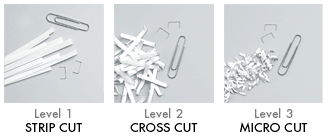This might seem like an odd question, but it is surprisingly effective in weeding out the shredding aficionados. There are several different ways information and documents can be disposed of, and even shredding has its own sub culture of shredding styles. Strip and Cross Cut are most commonly used for paper or card document disposal, but can also be used to shred data files, disks and even t-shirts.
What Is Strip Cutting?
A strip cutter is seen as the most basic kind of shredder, and is most commonly found in homes or small offices. It’s best used for domestic privacy or businesses requiring a very low level of security, as it is not the most sophisticated of shredders. A strip cut shredder takes the document and turns it into a series of vertical strips that look a little like strings of spaghetti. It can also process credit cards and even CD’s, though a lot of users note that the cheaper models will struggle to cut through materials the thicker they get. A strip shredder will generally produce 30-50 strips from a single sheet of A4 all around 2mm wide – that’s a lot of recycling! The main downside to strip cutters is that they are very low security. If an identity thief is determined enough, he could collect all of your shredding’s from your bins (once they hit the pavement it’s completely legal after all) and spend a lot of time putting them back together. Because you just have to match the strips to their neighbours, this becomes a fairly easy but time intensive task. If you’re feeling adventurous, print off this blog and put it through a strip shredder, and see how long it takes you to put it back together.
So What’s Cross Cutting?
Cross cut shredding is like the big brother of strip cut. While it’s not been around as long, it’s quickly risen through the ranks as one of the more popular option s for shredding, and it’s not hard to see why. The cutting cylinders of a cross cut machine not only cut the paper lengthways, but widthways too. The result of this method is a much thinner substance that resembles confetti, and you can get between 300 to 900 tiny pieces of paper from just one piece of A4 paper. The cross cut option is much more secure, as it prevents reassembly by determined thieves, and the resultant shreds are much more compact, saving space and increasing recycling potential. Unfortunately, cross cut shredding has only become a viable option to a lot of people in the last few years, as the cost was too great for anyone below mid level. Thankfully in recent years the costs of cross cut shredders have been coming down, and you can now even afford to buy one for your own home.
I’ve Never Even Heard Of Micro-Cutting!
Now you’d probably heard of strip and cross cutting, at least in passing, before reading this. But here’s a new one for you – micro cutting. That’s right, the next phase in shredding technology is here, with a more secure form of cutting stampeding onto the market. Micro cut shredders are similar to cross cut shredders, cutting paper in 2 directions to form a fine confetti type mulch, but a micro cut shredder can produce between 900-1500 tiny pieces from that same single A4 sheet. No matter how determined your thief, they will never be able to recreate the data that was once on that paper, so this style of cutting is perfect for anyone with high security concerns. And the good news is despite how new they are, micro cut shredders are still within an affordable price range, so you can make the most of your shredding and be confident that your secrets won’t be revealed.
Hopefully this blog has helped with your never ending quest to understand shredding a little bit better, and has shed some light on the many ways a document can be disposed of. If you have any questions about our preferred shredding style, or to see if we could help you destroy some documents, get in touch for a consultation today!


Recent Comments